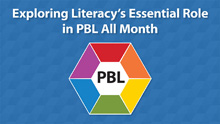When people hear the term “Project-Based Learning,” there are usually one of two misconceptions: It is where your class makes a project at the end of a unit or it is simply too chaotic. Both of these assumptions are truly that —“misconceptions.”
True PBL is a process where the students own their learning. They are simply told what to do, with clear guidelines. They are at the forefront, while the teacher serves as the facilitator. Students are engaged and the project is driving the unit instead of the unit driving a final product. Yes, things may look chaotic at times, but with proper training, students know what the expectations are. Student behavior usually is not a problem because they are so involved in the process. They know the purpose for learning the content. Students are working in collaborative groups, having making decisions about their learning. By doing this, they are working on conflict resolution skills, leadership, listening and speaking skills.
One of the Standards I recently taught my third grade students was the history of our community. Students needed to know why people chose to live in their community, what their rights and responsibilities were as a citizen of their community, how their community has changed over time and what drives shifts in population in their community. Through PBL, I was able to create a project where students were in control of learning this material.
I developed a driving question, “How does Shawnee’s past impact present day Shawnee?” This is open-ended question drives the unit. Students were placed in group of four or five students, where they wrote eight to 10 questions that could guide them to answering the driving question. They used these questions to help them with research. Next, students took notes, allowing them to understand Shawnee’s past.
 After doing this, we took a community walk. Each group had an iPad to take photos of our present day community. Students went into businesses, interviewing individuals on why they lived or worked in Shawnee and what they felt our community was doing well, and what needed to improve. To understand more about how they could be a responsible citizen, students completed random acts of kindness while we were on our walk.
After doing this, we took a community walk. Each group had an iPad to take photos of our present day community. Students went into businesses, interviewing individuals on why they lived or worked in Shawnee and what they felt our community was doing well, and what needed to improve. To understand more about how they could be a responsible citizen, students completed random acts of kindness while we were on our walk.
Another important aspect of PBL is including experts. This could be individuals coming in to speak with the students, or someone you are able to contact using Skype in the classroom. Our city manager made a presentation for the students so they could gather more information about Shawnee.
The final step was allowing the students to turn their research into a movie using Animoto. This was more of an authentic assessment, rather than having the students answer a multiple-choice test on our community. Students were assessed using a rubric, which they had been given at the beginning of the project.
Finally, the students needed someone to present their movies to. The city manager contacted city council members and other community leaders to attend our community movie presentations. Students became the experts, where they were able to applaud decisions and make suggestions to individuals who were the decision makers with what took place in our community.
Yes, PBL does mean you have to be willing to give up some control to your students, but in the end, it is well worth it.
Brandi Leggett is a National Board Certified Teacher as a Middle Childhood Generalist. She received her master’s in Elementary Education from Arcadia University in Glenside, Pa. She currently teaches third grade at Prairie Ridge Elementary in Shawnee, Kan. Follow her class during the school year at Team Leggett.